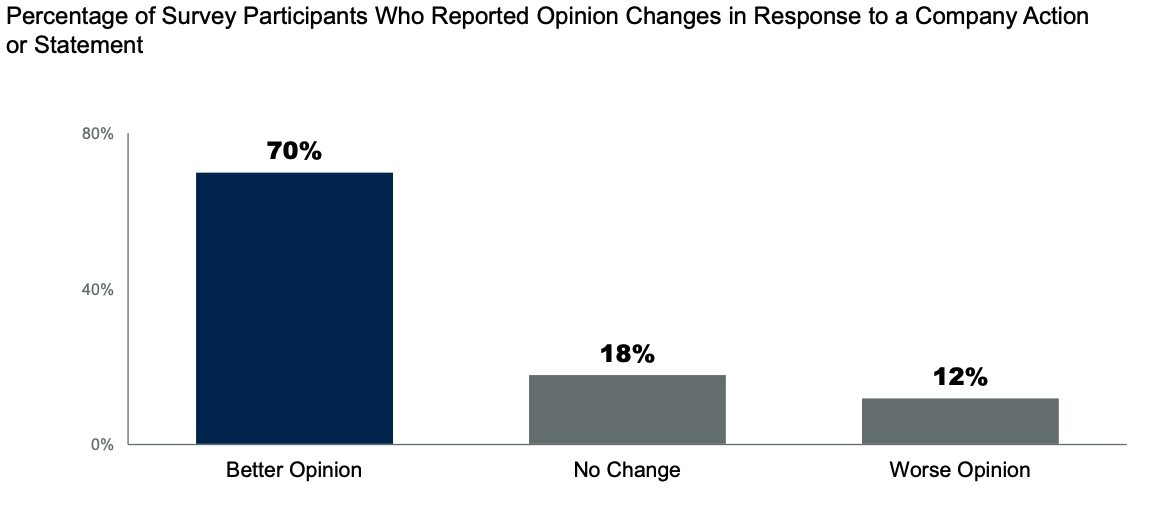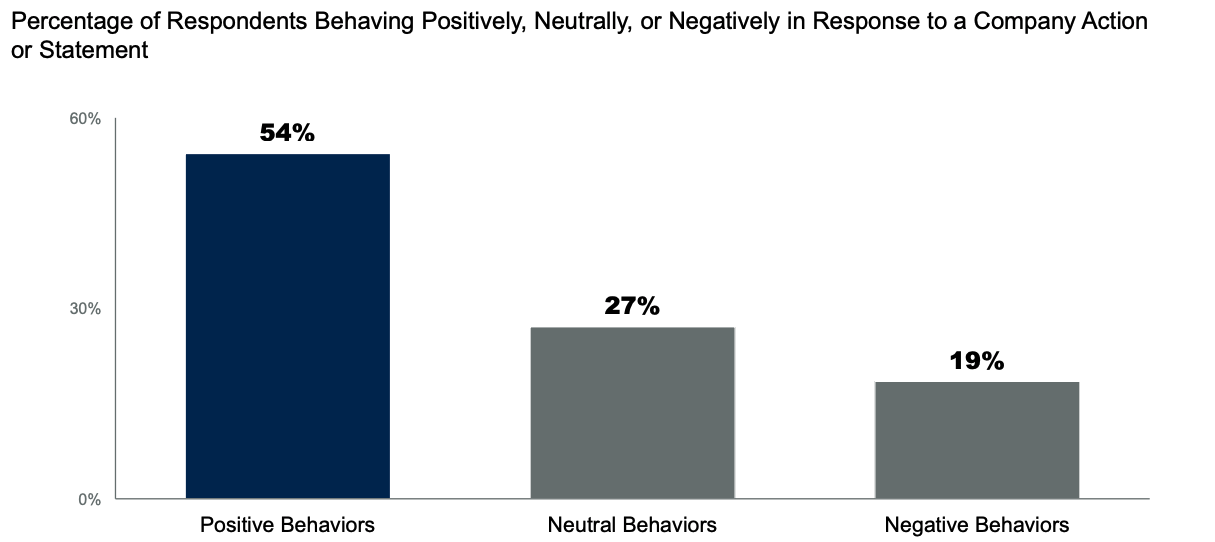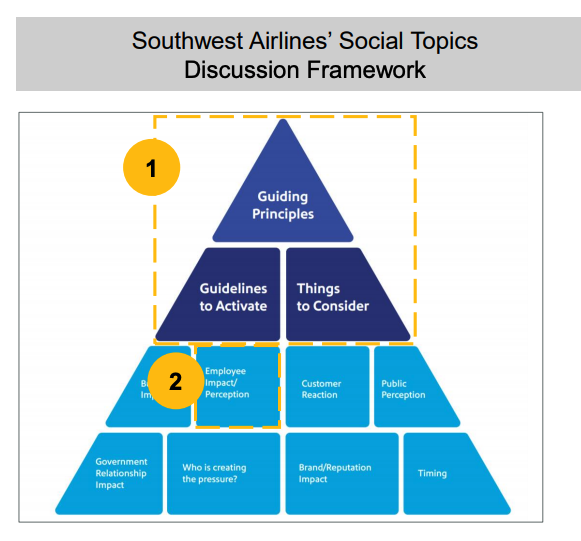The ‘say nothing’ approach to contentious issues means that people on both sides of the fence will think you’re against them, according to new research.
There’s a never ending supply of controversial social and political issues in the world. Individuals will often go to extraordinary lengths to publicly express their views on contentious matters – take the Hong Kong protests for example, which are into their 10th week – but businesses usually keep their lips zipped for fear of isolating a portion of their customer or client base.
Because you can’t harm your brand by keeping quiet, right? Well, new research from Gartner suggests that, yes, you can.
Gartner’s Karl Schmidt, practice vice president for the communications leadership council, and advisory director Patryck Allen, presented this new research at Gartner’s ReimagineHR Conference in Sydney last week and outlined how, and why, businesses should consider corporate advocacy.
Damned if you do, damned if you don’t
When a polarising issue sweeps a nation, how should businesses react?
Gartner found that employees hold their companies to a higher standard when it comes to taking a social stand than the general population.
Eighty-seven per cent of employees thought companies should take a stand on issues relevant to their business, compared to 70 per cent of the general population. Similar results are shown for issues that have no relevance to a business’ corporate objectives, with 48 per cent of the general population thinking businesses should take a position versus 74 per cent of employees.
There’s a strong appetite for businesses to take a stand, and it seems they aren’t meeting employee expectations. Ninety per cent of those surveyed were unable to recall an action or company statement being made on a social or political issue.
While businesses might feel keeping quiet is the safer option, the research suggests this inadvertently places them against everyone.
“There’s a dominant strategy that business have taken in the past and that’s to say nothing,” says Schmidt. “But that strategy isn’t going to work moving forward. Maybe it never did.”
“If you say nothing, everyone thinks that you’re siding with the other guy… which means you end up having no one supporting you,” says Schmidt.
Take the marriage equality debate. Qantas, for example, took a hard line on the ‘Yes’ side, covering its planes in rainbows and advocating for a yes vote on social media. The airline was just one of over 700 companies who publicly supported marriage equality.
New Daily journalist James Fernyhough took the 20 largest publicly-traded companies in Australia and found that only 11 had pledged support – those ‘on the fence’ included Westfield, Macquarie, CSL and RioTinto.
A spokesperson for CSL told Fernyhough that “the issue of whether or not to support same-sex marriage as a business had simply not come up”.
While this may very well be true, a statement like this says a lot more than that spokesperson may have intended. Someone who was an ardent supporter of the yes campaign, might have heard “we don’t support marriage equality” and someone who supported the no campaign might assume CSL was saying “we do support marriage equality but we’re not willing to speak about it publicly’.’
This is basically the finding of Gartner’s research. It doesn’t matter what CSL’s actual position on the matter is. Its silence allows people to fill in the gaps.
The benefits of corporate advocacy
Gartner’s research shows that of those who did take a stand on a contentious issue, the majority saw a positive impact on their business. Seventy per cent of people reported having a better opinion of the business after it took a stance and only 12 per cent had a worse opinion (see graph below).

Improved sentiment is nice, but it means very little unless action is taken. Gartner measured this too. Sixty-seven per cent of participants put these feelings into actions, such as:
- Personal advocacy (recommending the company to friends/telling friends to avoid doing business with a company)
- Customer purchases (brought more of a product or boycotted it)
- Public advocacy (joined a campaign to fight for or against a company’s goals)
- Employment (applied to work for the company or considered quitting)
While there were records of some ‘negative action’, like quitting the organisation after it took a stance, the results were overwhelmingly positive (see chart below).

In a separate piece of research, Gartner found that staff engagement levels were increased after seeing their employer engage in a social issue. Sixty per cent of employees felt their peers were more engaged and 18 per cent of staff had an increase in their discretionary efforts.
What do people care about?
Gartner asked survey respondents to share some of the social issues that their companies are involved in. The top ten were:
- Environment and climate change
- Race relations, corporate practices
- LGBTQ issues
- Data privacy
- Brexit and other geopolitical issues
- Civic engineers (political campaign donations)
- Public health
- Humanitarian aid
- Gun control
If you want to know more specifically what your people care about, Gartner recommends keeping a tally of issues that are brought up during company meetings, tapping into data from employee help desks, collecting data on the types of charities your staff engage with and, perhaps the most obvious of them all, ask an employee representative to share what matters to both them and their peers.
How to craft your message
It turns out that timing isn’t everything when it comes to responding to public issues.
“We’ve got more time than we think. There’s a general thought, which has some truth behind it, that says if we miss the boat we will get severely punished. But the interesting thing to come from this research is that unlike crisis communications… the chance of missing the boat when we engage in contentious issues is far less than we think. We can get on that boat a long time after it has sailed,” says Allen.
That’s not to say timing doesn’t matter. Stakeholders were five times more likely to have a negative response if they felt a message was delivered too late, but it’s not the be-all and end-all. The timeframe of crisis communications is between 1 day and just over one week. Gartner suggests that comments on general social issues can be made up to one month after the fact.
More important is crafting your message. Allen says the aim is to create net positive responses – minimize negative behaviours and maximise positive behaviours. To demonstrate how to achieve this, he separated company actions into those that have a strong impact and those that showed to have little to no significant impact at all.
For example, it didn’t appear to make a difference if the message came from the CEO or as a general message from ‘the company’, neither did the fact that it was a statement or an action from the company – both would be successful. Timing and tone had a moderate impact on stakeholder engagement. The top four factors for a strong influence were: consistency with company values, authenticity of the message, consistency with business goals and results that made some kind of impact on the issue at hand.
Stakeholders are 6.9 times more likely to have a positive response when they believe the company has made a strong positive impact on the issue at hand, and are 11 times more likely to feel positive when they believe that a business has stayed true to its values.
Putting it in context
So how do you actually go about constructing the message?
One suggestion Allen and Schmidt offered to the audience was the creation of a ‘social topics committee’ – the idea being these people identify important community issues and brainstorm appropriate responses (if any at all) to send out from the organisation.
“It’s important to have a diversity of perspectives [in these committees], otherwise you risk one person’s voice being the loudest. Getting that mix is really important,” says Schmidt.
He used Southwest Airlines as an example. Its committee consisted of: HR, a communications expert, legal, D&I, community outreach, government affairs and an investor relations representative.
The issue Southwest was responding to was the proposal to end the Deferred Action for Childhood Arrivals (DACA) program. By referring to its committee and relying on a pre-prepared pyramid structure outlining its communications priorities (see below), the company’s managing director of communications & outreach, Laurie Barnett, said they were able to respond confidently and quickly.
She also said their decision to speak out saw a fairly neutral response from the media and positive reactions from its own employees. If the media aren’t tearing you to shreds and your people are happy, that’s a win.

So how should you take advantage? Think about the latest big issue to take place in the headlines. Perhaps you’re thinking of NSW’s move towards decriminalising abortions, the appalling treatment of refugees in offshore detention, or any of the promises made in the lead up to the recent Federal election.
Did your company take a stance? If not, why do you think this was the case? HR leaders, can encourage the creation of social topic committees/employee representative groups to help generate appropriate responses where necessary. If the above data is anything to go by, you’ve got a lot more to gain by doing this than not.
The changes going on in society can often have a knock-on effect in the workplace and it’s important that leaders know how to respond. AHRI’s Ignition Wealth course Leading through change provides leaders with the right tools.


Interesting article. But it begs important questions, such as:
Would employees seriously be interested in the company taking a stand that differs from their personal opinions?
How does the concept of inclusiveness work when a company takes one side on a contentious issue?
If a company takes a position on a contentious issue, whose opinion is being adopted? The CEO’s? The Board majority opinion?
Where do shareholders – the people who actually own the company – fit in this picture?
Companies venturing into contentious issues in which the company has no particular expertise could end very badly.
The act of calling out actions, decisions or opinions that are inconsistent with an organisation’s values is important to create a workplace culture that is clear, aligned and positive. HR encourages people to do it when they see employee breaches. When an organisation sees breaches in the public sphere, corporate advocacy reinforces for their staff and customers that the organisation is serious about values such as inclusion, compassion, fairness, justice and respect. By engaging in advocacy, companies also strengthen democratic principles by engaging in important public discourse. Keep in mind too, many organisations funded to provide social services are either… Read more »
HR needs to be especially on-guard against activists of the GetUp variety pushing them into leftist agendas which are a total turn-off to the ‘Quite Australians’ who won’t hesitate to take their business elsewhere at significant cost to the bottom line.
It’s interesting that you imply that ‘quiet Australians’ who reject lobby groups like GetUp! are all right-leaning. I’m sure there are many people who choose not to speak up on contentious issues that still support values like fairness, compassion and courage. These are not the sole domain of any ‘side’ of politics (though interestingly they are the stated values of GetUp!). Indeed, the research cited in the article shows even ‘quiet’ people hold views and will respond positively when they see their values being upheld by employers. It is not just about taking a stand, it’s about what an employer… Read more »
How’s QANTAS’ support of same sex marriage working out for their brand image now that their planes are regularly turning around mid flight, and thousands of passengers have had their bags lost? Ultimately businesses should probably focus on doing what they do well (or communicating their why – according to the Simon Sinek model), otherwise as time has now proven, it can be simply looked upon as useless “virtue signalling”.